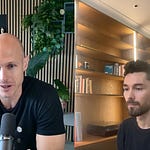Today’s episode is definitely on the nerdy side. But that’s a good thing - and for two reasons: 1) it means we actually get deep enough to deliver value to you and 2) this topic deserves much more attention than it usually gets - or to use Fred Destin’s words in our last episode:
You have no excuse not to be sophisticated when talking about portfolio construction and reserves. All the knowledge is out there. Learn. This matters to LPs.
Fred Destin, founding partner of Stride
With those words, meet Anubhav Srivastava, Founder and CEO of Tactyc - the unified platform for portfolio construction, modeling, management & reporting.
Founding Tactyc in 2019, Anubhav combined his passion for engineering and finance to solve the major pain points fund managers face with portfolio construction before, and notably after their fundraise.
Surprisingly forecasting & planning just did not exist as a use-case at most funds beyond the initial portfolio construction - and most funds that attempted this were just overwhelmed with spreadsheet mechanics.
Anubhav Srivastava, Tactyc
Today, Anubhav and his team work with 250 VC clients globally and have a growing European presence being trusted by firms like Atomico and Anthemis.
With a journey that traverses the realms of investment banking as well as the famed Hollywood talent agency CAA, Anubhav's story is one that inspires not only confidence, but also trust.
Getting to know Tactyc through the work associated with the production of this episode, we’re now excited users of the platform and can warmly recommend giving it a spin. In the bottom of this email, you can watch Anubhav taking David through the capabilities of the Tactyc platform 👀
Anubhav’s Journey into VC
Anubhav Srivastava's venture into the world of VC began with an unconventional twist. After completing his MBA at Wharton, he delved into investment banking on Wall Street, honing his skills in the traditional financial sector. However, his path took an unexpected turn when he joined the VC arm of the famed CAA (for a great episode that explains just why we call CAA famed, give a listen to Acquired’s episode with Michael Ovitz which takes you through how they disrupted how business is done in Hollyweird and how a talent agency is connected to the inception of a16z).
During his time at CAA, Anubhav experienced a data-driven approach to investing that went beyond the norm. The firm's quant-heavy strategies, detailed models, and scenario planning shaped his mindset to manage portfolios in a meticulous, data-driven manner.
I spent more time than is healthy for anyone to be in financial models and spreadsheets. And so when I first considered launching my own thing, it was a very logical problem that I was looking to solve because the financial model in the spreadsheet ecosystem was just too cumbersome.
Eager to put his skill set to use for the benefit of our industry, Anubhav launched Tactyc. Initially conceived as a general-purpose financial modeling platform, Tactyc quickly pivoted to focus on building the first forecasting and planning platform designed specifically for venture capitalists. Anubhav realized that forecasting and planning were often overlooked beyond the initial portfolio construction phase, leaving many funds drowning in spreadsheet mechanics. Tactyc aimed to simplify portfolio construction, forecasting, and active fund management.
Anubhav taking a stance.
In our chat with Anubhav, we challenged him to take a stance on the following quote by Sabina Wizander from Creandum:
"VCs deliver way less value to founders than they think they do”
Answering in part agreement and disagreement, Anubhav started by saying:
Founders need to be constantly challenging their investors to provide value, make requests, intros, suggestions - and then evaluate the VC performance. However a passive founder who sits back and waits for the VC to help them will rarely get any meaningful value from the relationship.
But he also makes it clear that the primary goal of a VC is to provide capital.
It's venture capital. It's not venture introductions, it's not venture strategy helping, it's venture capital … So your first value as a VC is obviously to provide the right capital at the right terms. And I think for the most part, VCs do a good job at that. Everything else after that is nice to have.
That said, Anubhav clearly recognizes the value of value add of VCs and shares how his own experience with MaC Venture Capital is a testament to this:
I'm saying this from experience. I leaned on my investors a lot. Like when I did my pivot, my entire first portfolio contruction plan was built by my investor, MaC Venture Capital. They were the ones that provided me that construction plan, so they could be the greatest value add to me.
Watch Sabina explaining her quote and Anubhav reacting to it below
Diving deep into building an efficient portfolio construction model for VCs
We built Tactyc first by taking a look at the existing quantitative workflows of successful fund managers.
Setting out to build Tactyc, it was clear to Anubhav that VCs had a lot of problems in common, some of them being:
How to properly build detailed probabilistic portfolio construction models
How to dynamically update their model with actual investments as the fund deploys capital
How to derive insights for the future deployment strategy from the fund’s actual performance and deployment vs. the original construction forecast
The key realization was that the best funds maintained a live financial model of their fund at all points (not just during construction). This is markedly different than most other venture funds who spend a lot of time on portfolio construction during their raise, but never open them again once the fund is launched. The problem of course being that it’s very difficult to maintain such a model in a spreadsheet. You need resources with great modeling skills to be able to manage a complicated spreadsheet ecosystem and a lot of time - and most funds simply don’t have that.
Through our work with eu.vc interviewing hundreds of managers for the podcast and angel investing actively in funds, we can definitely nod in agreement to that statement. And that’s ok, as Anubhav also stated:
The GPs core job should not be to build financial models, it's to find investments. And so, spending weeks and months building a construction plan is just not a good use of time.
And finally, Anubhav points out that there’s something very unique to how VC works:
There's a lot of variables. I don’t think tere's a correct or wrong way to do portfolio construction. There's just ways that are flexible or inflexible. And in most of the construction models we've seen, GPs build a very deterministic view of their portfolio saying: "I'm gonna do 30 deals. 20 of them are gonna fail, three of them are gonna be three x, four of them are gonna be 10 x and that's my construction model. “
But that's not portfolio construction. That's building a very specific version of the world that you think is gonna happen. But then tomorrow, if you decide to change your check size strategy, your reserve strategy, you have to throw the whole thing out and build it from scratch.
So the problem is, because the number of variables that go into a construction plan are so many and so interactive with each other, um, it needed a much more flexible platform to do that. And spreadsheets are just not the way to do that.
And then Anubhav points out something very important, which we have definitely seen confirmed:
Portfolio construction is something that everyone pays a lot of attention to when they're raising a fund. Once they've raised the fund, that spreadsheet never gets opened again. Until you’re raising the next fund of course.
Common patterns for best-in-class portfolio construction models
We asked Anubhav to give us his take on some common patterns in the best-in-class portfolio construction models. Here’s a selection of his findings from working close with 80 funds all the way from biggest managers to emerging managers:
They’re probabilistic, not deterministic. Meaning that they take into account the possibility of both positive and negative outcomes. For example, a model might assume that 50% of the companies in a fund will fail, 25% will be breakeven, and 25% will be successful.
They have a clear and counterintuitive way of thinking about reserves. Instead of stating a single reserve percentage, they derive it from thinking about graduation rate, target ownership, and other factors
All the best-in-class models had a very clear and almost counterintuitive way of thinking about reserves.
A regular portfolio construction model, plugs in a number for reserves, say 45%. But that actually hides away a lot of complexity. The best-in-class models were much more granular in their assumptions. Instead of setting a reserve number up front, the reserve number would be the output of things like their expected graduation rate and target ownership to be held for the next three funding rounds. So they were building on much more basic assumptions.
They were all very focused on getting the portfolio size right and having that as True North. And in doing so, they were building on actual data with power law dynamics held as a strong underlying assumption.
A lot of these great models that we saw built by these 80 funds were all built with actual market data in mind, which is incredibly important.
For instance, when investing in a specific region like Western Europe, it's crucial to consider valuation data that aligns with the sector, whether that's FinTech or Crypto.
If I'm investing in Western Europe, then I want to use round size valuations from Western Europe and from my sector specifically. You want to be very specific at that part of your market research.
It's also valuable to examine other funds' strategies and reserve approaches, although data availability may vary.
So what’s the ideal portfolio size? In reality, success in early-stage investments follows the power law. Therefore, as a pre-seed investor managing a portfolio of 15 companies, it would require exceptional diligence to mitigate the risks associated with such a diverse portfolio.
You must have the greatest diligence in the world to be able to de-risk some of those portfolios because that's a very hard thing to do.
Certain sectors like biotech may offer unique opportunities for investors with specific expertise. But for general, sector-agnostic investors without a distinct edge, aiming for a minimum of 30 deals per stage in the pre-seed phase seems advisable.
Solving for pre-final close investing
When raising funds, the reality is that the target amount may not always be fully achieved. In dealing with this, there are two approaches that can be taken.
The first approach is to assume the full amount will be raised and deploy checks based on the original strategy. However, if the full amount is not secured, there may be a shortfall, resulting in fewer deals and opportunities.
The second approach is to be more conservative. This involves adjusting check sizes initially and progressively working towards the target. This approach is often preferred in the current market environment, and it can be easily explained to Limited Partners later on.
It's important to be prepared for the scenario where the second close is not achieved. To accomplish this, maintaining a live forecast of the fund is crucial. Using a constantly updated model is essential, as a completely new model would mix actual deals with projected ones, leading to confusion.
You need a constantly alive model... maintaining a live forecast of your fund is really helpful. To do that in a spreadsheet is difficult.
In Tactyc, for example, a 70 million fund with 10 million deployed would be modeled separately. The performance of the deployed 10 million would be projected based on factors like graduation rates and risk rates. The remaining 60 million would be assumed to perform according to the original construction strategy, estimating the number of deals it would create. By combining the modelled 10 million with the forecast for the remaining 60 million, a new construction plan can be established.
So what about reserve allocation during this time?
First, as said earlier, solving for the number of deals is crucial. Secondly, it can be wise to work on the understanding that follow-on investments can be done through different vehicles like SPVs or opportunity funds, providing flexibility if necessary. This can be a quite favorable way of approaching it, as reserving capital upfront is challenging when you've only done a few deals and the actual deployment of that reserved capital may not happen for another two years. Instead, it might be considered more practical to invest in new companies as quickly as possible while keeping an eye on future needs.
Anubhav tells us that he has often seen fund managers over-reserving upfront creating an overly conservative model. In Tactyc this is addressed by calculating pro rata for the next round while factoring in the graduation rate.
Some of the companies might never graduate, so you might never get a chance to put your reserves behind them. So doing this, you get a better measure of how much you might wanna park away for the future.
For example, if the graduation rate from a Seed round to a Series A is 70%, risk-weighting the reserves would mean reserving only 70% of the pro rata needed. By risk-weighting the reserves based on graduation rates, you get a better understanding of the capital needed.
Tactyc - a coach as much as a piece of software
We started this article out by saying that VCs shouldn’t be spending all their time modeling. So we asked Anubhav what kind of assistance a user of Tactyc can expect. Let’s see what he says.
As a founder, a significant portion of my time, around 40%, is spent with clients. Some of it involves educating them and demonstrating how they should be using certain practices. It's important to note that these are not ideas pulled out of thin air but actual best practices we have observed, adding credibility to our approach.
During the onboarding process, a significant amount of time is dedicated to education. Initially, we conduct a comprehensive two-hour onboarding session with all of our clients, where we demonstrate the functionalities of the system. Additionally, in the initial stages, we closely guide our clients to ensure proper setup.
It's important to note that Tactic is designed to work when the entire team is actively involved, from the investment associate to the GP. Therefore, we prioritize training and ensure that everyone is equipped to use the platform effectively.
We invest a lot of time in education and have extensive documentation on guiding principles. Apart from Tactyc, we also guide our VCs on how to think about quantitative techniques and the benefits of having a forecast. It's not just about having a model; it's about using it to make informed decisions moving forward. This is a key aspect we emphasize to our clients.
Let me provide a couple of real-time examples that we've learned from our clients and transformed into features when applicable:
When it's time to deploy reserve capital after completing 10 deals, the question arises: which company should one invest in? Our clients approach this as an opportunity cost analysis, focusing on multiples. They forecast the growth potential of each company's next unit of currency invested and rank them accordingly. To help in this, we’ve developed an optimization function that helps allocate funds to companies with the highest multiples, considering actual and forecasted performance.
Another example is the desire of many clients to convert their RVPI (Residual Value to Paid-In capital) to DPI (Distributed to Paid-In capital). They often hold positions for a couple of years before considering selling 50% of their stake to realize distributions. However, selling at the fair market value might not be ideal as it could dilute the fund's internal rate of return (IRR) if a larger exit opportunity exists in the future. We offer an analysis where clients can determine the valuation at which selling 50% would maintain the same IRR as the current projection, avoiding a loss in returns. These analyses can be complex, requiring solvers to find optimal valuations. In Tactic, we've automated a minimum partial sales evaluation calculation that suggests the appropriate sale price for each deal, preserving the fund's IRR.
These are the types of analyses we learn from our clients and strive to share back with them to foster education and understanding.
Watch the full segment below 👀
Anubhav’s shout-out 💌
Anubhav acknowledges MaC Venture Capital, particularly Michael Palank, as one of their earliest investors who worked closely with them to develop a robust portfolio construction plan and facilitated key connections within networks.
Michael worked with us extensively to develop a solid portfolio construction plan, and connect us with different networks, such as Kauffman Fellows.
A product like Tactyc cannot work in isolation - it has to be built in partnership with VCs. Some of our early clients, such as Tusk Venture Partners, Atomico, Motivate, Munich Re are examples of clients we have worked closely to build a product tailed for VCs.
Anubhav expresses profound gratitude for the pivot that MaC Venture Capital enabled, highlighting Michael's instrumental role in building the portfolio construction dashboard.
We pivoted our company, when we realeased a portfolio construction dashboard.
The person who built it was Michael Palank, a GP at MaC Venture Capital. And I couldn't be more grateful for that pivot that he gave us. He has been tremendous for connecting us with the right people, broadcasting about us, and speaking aboit portfolio construction.
We’ve done podcasts together, webinars together, blog posts together. I am more than fortunate to have an investor like him. Besides capital, I was extremely lucky to have him guide our product.
Anubhav’s Three Biggest Learnings
1. Never underestimate the power of small teams.
Anubhav emphasizes the power of small teams, highlighting their ability to move mountains quicker than larger incumbents. He urges founders to leverage this advantage by making faster decisions and shipping products rapidly.
They can move mountains quicker than large incumbents by 100x. Use that to your advantage. Make faster decisions, and ship products faster, and larger incumbents will still be stuck under process.
I personally conduct every demo of Tactic because it allows me to learn, shape our product strategy, and drive our engineering efforts. If I had additional layers of sales reps or engineers, important details could get lost in translation. Being directly involved enables me to move fast and respond quickly to client needs. I can implement feature requests within hours, ensuring we deliver a seamless experience. That's the strength of a small, agile team.
2. Focus on controllable - and be cognizant of the risk factors outside your control.
Anubhav's second learning centers around focusing on controllable and being aware of the risk factors outside one's control. As a founder, he stresses the importance of directing energy toward what can be controlled, such as product development and sales processes.
For VCs, Anubhav believes that while they cannot control the performance of their portfolio companies, they can control their portfolio construction and investing strategies.
As a founder, this means I focus on our product, our customers, and our roadmap. I cannot control things like (a) competition or (b) whether I can successfully close a sale.
I can only focus on our product, our sales process, how we demo the product, and how we communicate the product to the client.
In the context of the venture, I’ve realized GPs cannot truly control the performance outcome of their portfolio companies, no matter how great their value-add or diligence process - so the only thing they can control is their portfolio construction (how many deals) and investing strategy (check sizes and reserve strategy).
3. Ignore the naysayers
Lastly, Anubhav encourages entrepreneurs to ignore the naysayers and bias toward action. He acknowledges that startups rarely have a perfect strategy from day one and advises founders to evolve and adapt their strategies over time.
When you're first starting a company, it's mostly just about the passion, about wanting to see a product out in the world. Then the rest of the chips, you figure it out as you go. So, if an investor or someone else is asking you in your first year or what's your competitive mode, ignore it right now.
Just continue building.
Anubhav's insights serve as invaluable guidance for aspiring founders and VCs alike, reminding them to embrace small teams, focus on what can be controlled, and have the courage to defy conventional wisdom.
It’s easy to say when a company will fail (small TAM, lack of competitive moat, etc.)
These are things that we are taught as MBAs to evaluate - and it’s easy to “play founder”, but bias to action is rare. Rarely do startups have the perfect strategy from Day 1, instead, the strategy evolves and changes over time to address these questions or perceived weaknesses.
🔫 The Quickfire Round 🔫
Q: What advice would you give your 10 year younger self?
One of the most impactful books I've encountered in the last 15 years was:
Malcolm Gladwell's "Outliers."
It truly opened my eyes to the immense power of dedicating oneself to a craft for a substantial period of time. Becoming a world-class expert by excelling in something for a decade is a concept that deeply resonated with me.
However, there's another book that left an indelible mark on my thinking:
Talent is Overrated" by Jeff Colvin.
It challenges the notion that talent is the ultimate determinant of success. Instead, Colvin emphasizes the significance of deliberate practice—a relentless pursuit of mastery over an extended duration, surpassing all competition.
Personally, I realized that my path diverged from the conventional wisdom of focusing on one discipline for an extended period. Instead, I ventured into multiple domains, striving to excel in each. As an engineer, I delved into investment banking, explored the realms of venture capital, and even embraced the challenges of sales. Although I never achieved world-class status in any one area, this multidisciplinary approach allowed me to connect the dots and foster creativity.
Nevertheless, if I were to revisit my journey from a decade ago, I would advise myself to keep pushing boundaries, exploring new horizons, and pursuing excellence in various disciplines. By doing so, I believe remarkable opportunities and unforeseen creative avenues can emerge, shaping a truly exceptional path forward.
Q: What are your top tips for emerging VCs that are fundraising across Europe?
1. Don’t over egineer the waterfall structure right from the start.
Go with the standard waterfall, the tried and tested two in 20 model for your initial portfolio construction. It's more than sufficient. If necessary, consider including an anchor investor if you're concerned about securing a standard waterfall.
Focus your energy on the portfolio construction side of things. Clearly define how you will communicate to LPs what your projected power law curve looks like. LPs often inquire about this, wondering which charts are crucial among the plethora of options available.
We have a best practices guideline on this, but one chart that should always be shared is your projected power law curve. Explain the expected number of failed deals, the range of returns between one and three times the investment, and the underlying graduation rates and exit rates.
Be transparent about what this curve entails.
2. Understand the capabilities and limitations of your fund admin.
Sometimes, there is confusion about whether a fund administrator can fulfill the role of Tactyc. Fund administrators excel at reporting and accounting, crucial operational tasks.
However, they do not cover forecasting, planning, reserve allocation, portfolio construction, and strategic elements that you'll need to address. It's essential to recognize that you still require a specialized function for these crucial aspects, whether it's Tactyc, an Excel spreadsheet, or even the back of a napkin.
The important thing is that you address responsibilities effectively.
3. Have a unique and compelling thesis.
The third piece of advice I've repeated numerous times is particularly relevant for pre-seed investors aiming for a portfolio size of 20 companies or less. In such cases, it's crucial to have a unique edge or a compelling thesis within the biotech space, clearly communicated to differentiate yourself.
Deviating from standard patterns requires a well-articulated and distinct value proposition.
4. Reserve allocation is an opportunity cost analysis.
When you reach the stage of deploying capital, remember that reserve allocation is an opportunity cost analysis. You need an objective measure to determine where the next dollar will be most effectively utilized. Whether you use a multiple-factor approach or perform internal rate of return calculations, establish a framework to guide your decisions.
One common pitfall for GPs is allowing reserves to become an emotional decision. Avoid falling into subjective biases based on personal preferences or relationships with founders. Maintain objectivity throughout the reserve allocation process.
Q: What's the most counterintuitive thing you've learned since you've been in VC?
I've learned some counterintuitive lessons along my journey as a founder, and one of them pertains to smaller funds. Surprisingly, smaller funds often come with more complicated waterfalls.
We've encountered cases where there are multiple anchor investors and various complexities, even for funds as small as 2 or 3 million. Sometimes, even Tactyc struggles to find solutions because these models have deviated so far from the standard structure. I understand that these complications arise because many of these funds have evolved from angel investing, bringing along the baggage accumulated in that realm. It's a challenging problem for us to constantly address and find resolutions for.
Another lesson I've embraced as a founder might not be extremely counterintuitive, but it's a valuable insight—avoid overhiring.
Sometimes, there's pressure to rapidly expand the team, with suggestions to increase the company's size tenfold. However, I've realized that rushing the hiring process can actually hinder progress and dilute our product velocity and focus. Scaling too fast at the wrong time can be detrimental.
While I believe we will reach a point where scaling becomes necessary, I want to be deliberate and mindful about how we approach and execute the hiring process.
Anubhav’s Controversial Statement.
Now, brace yourselves, because what I'm about to share might spark controversy.
We conducted an analysis comparing TVPI (total value to paid-in capital) to the number of tweets, and the results were surprising. In fact, it showed a flat to potentially negative correlation between TVPI to Tweet ratio. I know, it sounds outrageous, but bear with me.
Granted, we must consider the factor of vintage years and allow for several vintages to pass before drawing conclusive insights. However, based on our current observations, the most successful investors in our portfolio, and among our esteemed clientele, tend to be the silent ones.
They quietly observe, learn, invest, and engage in meaningful conversations with companies. Occasionally, they might share a tweet or two, but they are not constantly broadcasting their every move.
Now, let me be clear—I understand the reasons behind the need for visibility and networking, especially when it comes to peers and industry recognition. It holds significance.
However, it's essential to take this data for what it is—a snapshot of the current state. The data suggests that, at least for now, the correlation between excessive tweeting and investment success is not as strong as one might assume.
So, let's engage in a healthy debate, acknowledging that the landscape may shift over time. But for now, let's not dismiss the possibility that silence could be a powerful virtue in investing.
Watch Anubhav demo Tactyc to David below
As said earlier, we’ve been blown away by the power of Tactyc and are now using it to manage our Angel LP Portfolio. Love it. Surely, more insights to follow!
Join us tonight for the webinar “AI & VC: A New Investment Era”
JULY 25TH, 2023 at 7 PM CET
Affinity is hosting a first class webinar tonight on how Artificial intelligence is transforming Venture Capital with nonother than Peregrine Badger, Instigator at Fifty Years and Adam Perelman, Engineering Manager of ChatGPT at OpenAI all moderated by Ray Zhou, co-founder and CEO of Affinity.
In the webinar, the panel will discuss how VCs are using AI in:
Identifying and researching potential investment opportunities
Assessing the financial and operational health of potential investments
Tracking the performance of investments and making exit decisions













